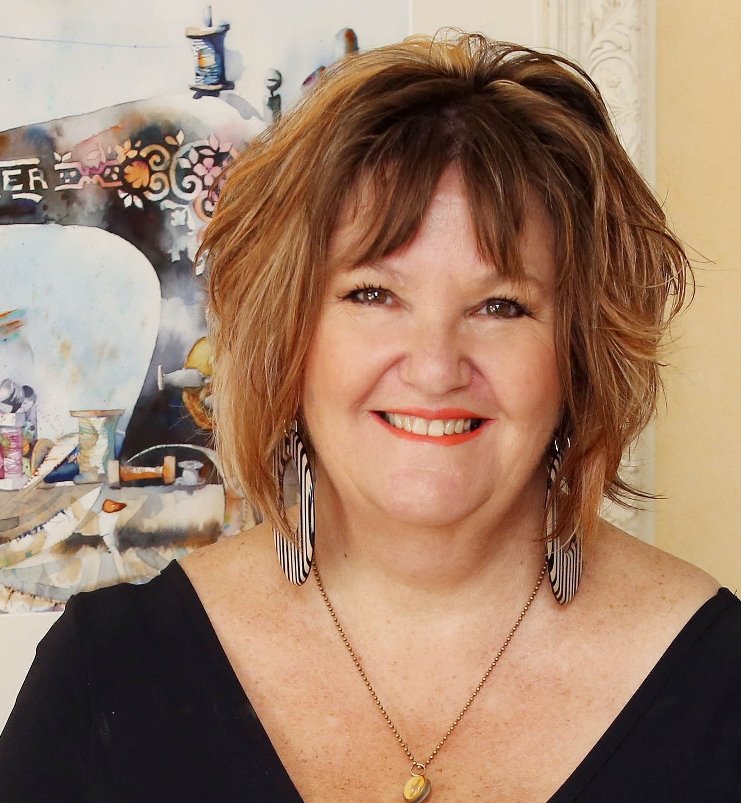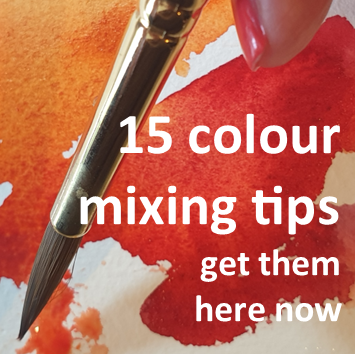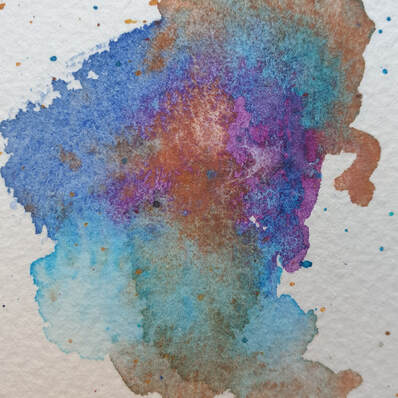
Hello there *|FNAME|*
I can't tell you how many times my students say these words - it occurs to me that none of them are useful, enlightening or positive. All they achieve is making people feel miserable about what they're trying to accomplish! Let's strike these words from our vocabulary TODAY!! Mud In watercolour there is an overuse of the word mud. It is now used to describe anything the painter doesn’t like in their painting - without evaluation or critique – it’s just mud! Actual mud is very difficult to create, however people who have painted in other mediums seem to be particularly adept at the chief skill required – overmixing. Mud is the usual description when the lights (whites) are lost and the painting seems overrun with neutrals and mid values. The true issue is the painting is not finished and seems awash with nothing in particular. its a difficult stage to push through. Watercolour needs a light touch in every possible way, much like making scones or a difficult putt – less is more! In the early phase of your learning, make things easier for yourself and only use a good quality brand of transparent colours – you’ll only need 3 primaries to start with. Mix your colours on the paper with one or two brushstrokes (I’m not kidding!) and then keep your hands off – walk away and make a cuppa!! The problem with the word mud is it’s negative connotations – mud from the river is dirty thick and horrible. In watercolour painting, what mud really is, is neutral. It makes your brights and focal point stand-out. To make neutrals while retaining harmony in your painting, all you need to neutralise a colour is to add the tiniest touch of it’s complementary. Fix Another overused word. I have to admit, I say this myself from time-to-time, there is a difference however - I know why I'm saying it - I'm saying it with purpose and knowledge. Beginners are saying it because that's what they've heard other people say and they lack confidence in their work. Again, the actual problem is your painting is not finished. It’s out of balance and your creative brain knows it but you are not in practised at evaluating or articulating it. The word “fix” implies our painting is wrong or bad. For the beginner the difficulty is how to resolve our work so we can finish. It’s not easy, no art is. Further, nothing worthwhile is easy, that’s why we do it! It’s a journey, learning to see, learning to draw and learning to paint. Learning what we like and don’t like. Learning to talk to ourselves in more productive and kinder ways. Perfect I feel like a broken record about this, it comes up so often. Sometimes I get so angry and frustrated that so many creative people have been thwarted by this nonsense. Firstly, we’re making something by hand – it’s going to have some exciting variations! “Perfection” is a way for our creativity to be curbed by ourselves or by others. We’re really repeating what some dummy said to us when we were kids. I was lucky as a young maker. My role model mother was a constant maker but with a few children she had little time for neatening edges and playing with niceties. She made us gorgeous little dresses with coats and bonnets to match. A super clever woman but DON’T CHECK the inside!! Actually, you've reminded me that my sister's dance costume fell apart on stage once, I don't think she was phased at all - the show must go on - what a great girl - just like her Mum!! I remember everyone running around looking for safety pins!! Here’s a question: What is Perfection? Describe it. I defy you!! Let’s also remember, one man’s meat is another man’s poison. In my experience “Perfect” is used as a manipulation tool. They can’t describe how they want “it” and leave you to make up your own exciting creation and then they are very quick to tell you it’s not Perfect, it’s wrong and how badly you’ve done! But they still don’t tell you what they want!! Do not get sucked into this vortex of someone else’s nonsense, don’t be a victim and don’t pass it on!! Mistake Who cares? As above, the reality is, your painting is not finished and needs something to balance it. Work out what it needs to be resolved. Does it need to be lighter, darker, less bright, more bright? There are no mistakes in watercolour, however, you might get a few surprises along the way. And this, my friend, is the gift that does our heads in!! When we receive a surprise from the watercolour Gods, we need to stop and think. How can we use this gift? The answer might take a little while to present itself, we just need to pretend we are patient and wait for it to appear. Initially, I recommend ignoring it. I often find by the time I finish my painting, I’ve forgotten about it. However, if it’s still bothering you, it must need to be resolved. Watercolour is Backwards Whenever I hear this it makes me crack up – it’s just so stupid! It’s never said by a true watercolour artist. Watercolour is a forward medium. We start with white paper, then add a light value, then we add a medium value, then a mid dark value and finally a dark value. – we come forward from light to dark! Much the same as pencil sketching. Only opaque medium artists focus on obliterating the white canvas with a dark value and then paint increasingly lighter values - now that’s backwards! ‘Nuff said!! Fade modern watercolours don't fade they dry lighter much like acrylics dry darker. the watercolour painter must compensate for this and use more pigment - if it looks right when its wet, its probably wrong. using the word fade perpetuates old stories and nonsense. As in any situation anywhere, using the right words sets the story straight and reduces misunderstandings. ciao cari pittori!!
6 Comments
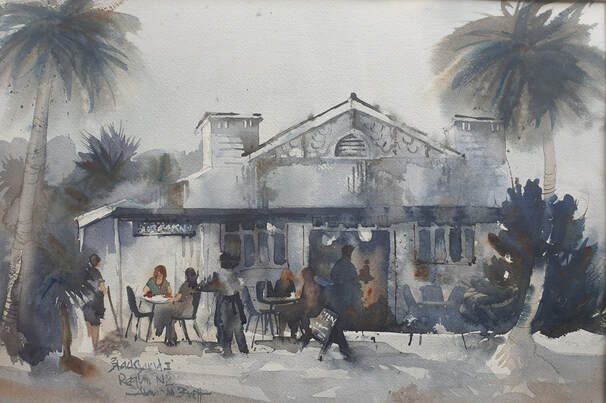 Blacksand, painted en plein air in Raglan NZ. Available from Splash 2022, Wellington NZ Blacksand, painted en plein air in Raglan NZ. Available from Splash 2022, Wellington NZ
A key issue for any artist is creating a focal point.
Have you ever asked yourself "Where should I start?" or "What's my story?" This is where your story is and where you want your viewers to look. Everything else is background. There are many ways to achieve this, my favourite is to divide my painting surface into thirds vertically and horizontally, aka the golden section, then use one of intersections for my focal point. This means that (unless your painting is square) your focal point will be unequal distance from any edge of your substrate, creating a discordance, a little bit of a shock – why isn’t it equal? It just feels like the natural spot! Many students ask me “where should I start?”. It doesn’t really matter except that, especially for beginners, a good place to start your painting is at the place that’s most exciting for you, the thing that got you interested, then build a background around it. This ensures you keep the background in the background and your focal area is full of exciting stuff and further, you’re enjoying what piqued your interest to start with. A focal point is also discussed as “your story”. Again I’m often asked “what do they mean, what is my story?” It doesn't have to be anything deep, dark and meaningful unless that's what you want to communicate. Your story is a description of what inspired you to paint: Eg I like the way the light hit the tablecloth and refracted through a glass of drinking water, making a super bright highlight on a pear and beautiful light and shadow shapes that danced over the folds of a tea towel. Write this in your sketch/notebook with your sketches, to keep your memory alive. This is a good habit for several reasons, but first of all, it aids your thinking processes; further, it’s your evidence of originality and your body of work and even more, galleries may ask you for descriptions; when stressed over preparing for shows the last thing you want to do is have to write descriptors – your early writings hold the key to your original inspiration. Along with your drawings, sketches and composition thumbnails, it is a good idea to write a list of accompaniments so you’re not stuck for ideas and feel forced to finish without having thought through thoroughly (crikey!) before you started. For example a table top painting might also include a vase and flowers, a suggestion of a chair, bottle of tomato sauce, a lemon and a spoon. In the background: light though a window, painting on the wall, books on a bookshelf and a table lamp. Once you have given your focal area a good start you can then move on to painting other areas of the painting and adjust and balance the painting later. It really all comes down to planning and understanding what you want to paint and why. Asking yourself these questions will help you to get to the heart of the matter quickly, help you to focus your concentration and get to picking up that brush sooner!! do feel free to comment or ask a question! ciao cari pittori!! 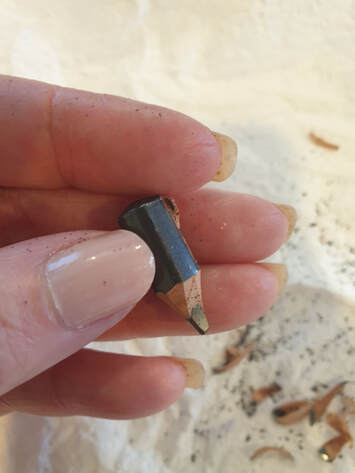
Some thoughts on drawing!
Drawing skills are essential. Your painting will improve out of sight just by spending 10-20 minutes observational drawing every day. Shapes must be good - note I didn't say "perfect". "Good" can also mean interesting, unique or beautiful. Design your artwork with design principles in mind. Accomplished drawers/designers/artists can and do paint without drawing on their paper BUT 99.9% will have mapped out their design idea as a sketch first and will have spent much time studying and researching and planning – they’ve possibly painted a similar subject 500 times before – they know it well but have found a new intriguing “thing”. Some watercolour tutors disagree with this, it shows in their work. Drawing can become a 5-minute exercise in order to create a good painting (oil, acrylic, watercolour, sculpture, pastel), it doesn't matter the medium, art is art. "Wrong" marks are full of character and shouldn't be erased (unless they're really annoying and stuck in your head then have at it!). It takes skill and practice - draw every day, start simple. An eraser is not an essential tool but your sharpening device is. There are many different purposes for drawing, some for me are:
The word "perfect" must be stricken from your vocabulary - it is meaningless because it can't be articulated, is subjective and stops us from doing what we really want to do! Please comment and ask me questions and let me know how you're getting on!! |
AuthorPaintBox Tips, secrets, random thoughts, Poetry in watercolour is made in the freedom of the here and now. Amanda Brett Inspiration exists, but it has to find you working - Pablo Picasso There are no mistakes in watercolour, just some extra surprises!! Categories
All
What my readers and viewers have to say
Your emails are so informative! I must confess I've watched a couple of your demos from beginning to end, and it makes me want to watercolor!!! I've only ever painted with oil or acrylics and haven't know how to begin with WC. Your content is excellent!
Susan VN Hi Amanda
Thank you for your tips. They inspired me to practise and I realised I haven’t been loading the brush properly. I learnt about adding more paint, and not water, to washes. In today’s tips I like the idea of painting with purpose. Your tips are very helpful. I very much appreciate receiving them. Elizabeth Hi Amanda I enjoyed your post and generous tips. Looked up Dan Burt I begin to see that you can colour any subject to give it pizazz so long as the tone and form is correct Certainly adding value now to my attempts Thanks heaps Annie
Yes very wise words. Agree with not fussing and agree with comments about good quality paint. Well written and inspirational as always. Cheers Janet xxxx Archives
July 2023
Copyright © 2022 All images and text on Amanda's blog and website are the the legal property of Amanda Brett and may not be reproduced without express permission from Amanda Brett or her authorised agent. Thank you for respecting her art and the livelihood of all artists.
|



